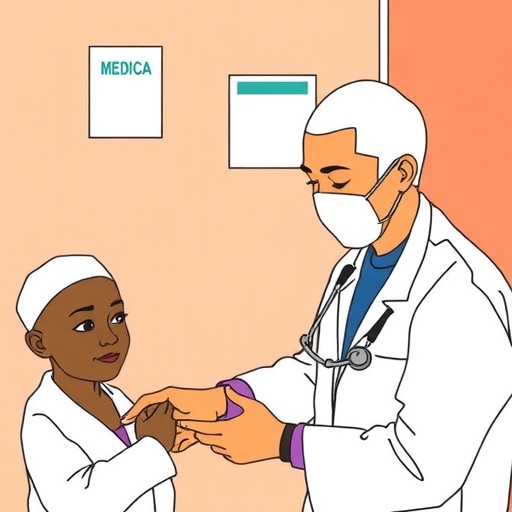In the labyrinthine alleys of Bangladesh’s sprawling urban slums, access to medically trained healthcare providers remains a formidable challenge. A groundbreaking implementation research study recently published in the International Journal for Equity in Health sheds light on an innovative pilot primary healthcare model designed to bridge this critical gap for low-income populations. The study, conducted by Rabbani, Hossain, Tisha, and colleagues, meticulously explores how a tailored urban healthcare framework can pivot healthcare utilization toward trained professionals, potentially transforming the healthcare landscape in marginalized communities.
Urban slums in developing countries often present a cocktail of socio-economic hardships, environmental hazards, and systemic inadequacies that exacerbate health disparities. Bangladesh, with its rapidly expanding urban populations and constrained healthcare infrastructure, encapsulates these challenges poignantly. In such settings, residents frequently rely on untrained informal providers, which may compromise the quality of care and exacerbate health inequities. The study’s impetus arises from this public health conundrum, underscoring the urgency to evaluate interventions that can recalibrate healthcare seeking behaviors within vulnerable urban cohorts.
The pilot primary healthcare model under scrutiny adopts a multifaceted approach, integrating accessibility, affordability, and cultural competence. Central to this model is the establishment of community-based healthcare units staffed exclusively by medically trained providers, embedded directly within slum environments. This strategic positioning aims not only to reduce physical and economic barriers but also to engender trust and familiarity between providers and residents. The researchers hypothesized that proximal, reliable healthcare sources would encourage greater utilization of qualified services in lieu of unregulated alternatives.
Methodologically, the study employed a robust implementation research framework, combining quantitative surveys with qualitative interviews to capture nuanced shifts in health-seeking patterns. Baseline data underscored that prior to the intervention, a negligible fraction of slum dwellers accessed medically trained personnel for primary health concerns, with informal providers dominating the landscape. Post-intervention assessments revealed a discernible increase in the use of qualified healthcare services, suggesting a positive impact of the pilot model. The researchers attribute this shift to both reduced logistical hurdles and enhanced community engagement fostering health literacy.
The findings articulate a compelling narrative about healthcare equity in urban slums, where the conventional dichotomy between supply and demand is reframed through an implementation lens. By reallocating resources to community-centric models that value contextual realities, the intervention demonstrates scalability and adaptability. Notably, the pilot also highlights how empowering medically trained providers in underserved locales can galvanize trust, a critical determinant influencing healthcare decisions amidst pervasive skepticism toward formal systems.
Delving deeper, the study elucidates the transformative power of integrating health education within the model. Beyond mere physical provisioning of services, health promotion initiatives tailored to the slum’s socio-cultural fabric emerged as pivotal. These educational components, delivered in local dialects by community health workers, dismantled misconceptions and underscored the benefits of seeking qualified care. This dual approach—combining service availability with empowerment—effectively catalyzed behavioral change, a benchmark achievement in implementation science.
Furthermore, addressing financial barriers epitomized a cornerstone of the pilot’s success. The healthcare units operated on a subsidized fee structure, which, in conjunction with flexible payment options, ameliorated affordability challenges conventional models often overlook. This economic recalibration not only enhanced access but also safeguarded the financial resilience of impoverished households, averting catastrophic health expenditure scenarios. The study meticulously quantifies this dimension, underscoring the intersection of health economics and equity.
The research does not shy away from confronting operational obstacles encountered during implementation. Issues such as intermittent resource constraints, provider retention challenges, and infrastructural inadequacies highlight the complicated terrain of urban healthcare reform. However, by advocating for continuous adaptive management and stakeholder involvement, the study delineates actionable pathways for overcoming systemic inertia. This reflective component of the research advances the discourse on sustainable health interventions.
Importantly, the interdisciplinary nature of the study bridges public health, urban planning, and social sciences, fostering a holistic understanding of slum health dynamics. The authors emphasize that urban health interventions cannot succeed in isolation from broader socio-economic reforms. Integrating the pilot model with policies addressing housing, sanitation, and employment amplifies its impact, crafting an intersectoral mosaic essential for durable health equity.
The implications of this research resonate far beyond Bangladesh. As urban slum populations burgeon globally, particularly in Asia and Africa, the pilot model offers a replicable blueprint adaptable to varying contexts. The evidence presented advocates for a paradigm shift, urging international health agencies and governments to prioritize community-embedded, medically supervised primary healthcare solutions tailored to marginalized urban populations.
Equally noteworthy is the study’s contribution to implementation science itself. By rigorously evaluating real-world applicability, the research transcends theoretical constructs, providing empirical substantiation for practical healthcare innovation. This translational approach embodies the quintessence of effective public health research, where evidence is not confined to academic corridors but dynamically informs policy and practice.
In conclusion, Rabbani et al.’s study punctuates the discourse on urban health inequity with data-driven optimism. It illuminates how strategic, context-sensitive interventions can reorient healthcare behaviors among low-income urban dwellers, steering them towards safer, more effective medical care. This research invigorates hope for slum communities traditionally sidelined in global health narratives, carving pathways for equitable, accessible, and sustainable urban healthcare futures.
Subject of Research: The influence of an urban primary healthcare model on the use of medically trained healthcare providers among low-income slum populations in Bangladesh.
Article Title: Influence of a pilot urban primary healthcare model on the use of medically trained healthcare providers among the low-income slum populations in Bangladesh: findings from an implementation research study.
Article References:
Rabbani, M., Hossain, Z., Tisha, K.I. et al. Influence of a pilot urban primary healthcare model on the use of medically trained healthcare providers among the low-income slum populations in Bangladesh: findings from an implementation research study. Int J Equity Health 24, 273 (2025). https://doi.org/10.1186/s12939-025-02622-z
Image Credits: AI Generated




